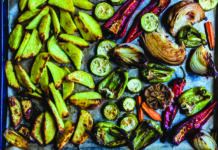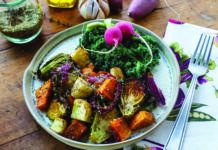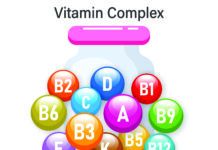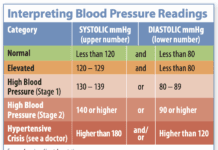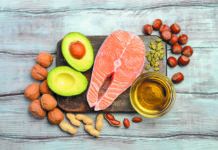Image © Wavebreakmedia | Getty Images

When people resolve to “eat better,” one of the first things they think of is to start eating more salads. After all, the structure of a great salad is built on vegetables, particularly leafy greens. Vegetables, along with fruits, are the foundation of healthy eating patterns, as emphasized by the 2015-2020 Dietary Guidelines for Americans. For a 2,000-calorie diet, the Guidelines recommend the equivalent of about 5 cups of vegetables and fruits per day.
The majority of Americans fall short on that recommendation. One easy way to remedy this situation is to include more salads in your regular eating pattern. And when topped with foods besides vegetables, salads can become complete meals and nutritional powerhouses, moving you towards a pattern associated with better health—including lower risks for heart disease, diabetes and cancer.
“Salads are a great way to fill up on several other healthy foods, such as nuts, seeds, fruits, plant oils and other nutritious toppings,” says Dariush Mozaffarian, MD, DrPH, Dean of the Friedman School and editor-in-chief of Tufts Health & Nutrition Letter. “To get the most benefits from salads, emphasize healthy ingredients and minimize unhealthy choices.”
Image © Luisrftc | Getty Images

Unhealthy choices include some store-bought salad dressings—those that contain high amounts of added sugar and salt—and processed meats like bacon and cured lunch meats. Store-bought croutons, like many refined-grain products, may have excessive amounts of sodium and are devoid of fiber.
Salads are as diverse as the ingredients and food cultures that contribute to them. However, there are some basic rules of thumb that can help you to benefit the most from salads, either as a main meal or a side dish.
“Choose a variety of ingredients that provide a broad spectrum of colors to ensure a nutrient-dense mix and add interest and complexity, and a variety of textures that add crunch and diversity,” says Alice H. Lichtenstein, DSc, director of Tufts’ HNRCA Cardiovascular Nutrition Laboratory and executive editor of Tufts Health & Nutrition Letter. “Think of salads as a great way to incorporate healthy liquid plant oils into your diet. Salads add color and flavor to a meal and can be customized to meet personal preferences so they satisfy anyone’s tastes.”
Greens: As the foundation of a traditional salad, the healthiest leafy green choices are dark greens. Popular dark greens include spinach, arugula, collard, Swiss chard, kale and mustard. A recent study in Neurology provided evidence of brain-protecting benefits of dark leafy greens. The study involved 960 people, ages 58 to 99, tracked for an average of 5 years. Those who ate 1 to 2 daily servings of leafy green vegetables had slower age-related decline in memory and other mental skills than those eating fewer servings. Participants who consumed the most servings tested as being the equivalent of 11 years younger in their mental skills, compared with those who rarely or never ate leafy greens.
In another recent study, published in the Journal of the American Heart Association, older women who reported eating three or more servings of vegetables a day had less thickening of the walls of the carotid arteries, compared with women who ate fewer than 2 servings daily. The carotid arteries (on the side of your neck) supply blood to the brain. Thickening of the carotid walls can be a warning sign of “hardening of the arteries” and a higher risk of stroke. Of all the vegetable types included in the study, the cruciferous vegetables—broccoli, cauliflower and cabbage—seemed to have the most pronounced association with healthier carotid arteries.
“These studies provide additional confirmation—this time in older women—that people who reported eating diets higher in vegetables reap a cardiovascular protective advantage,” Lichtenstein notes.
Going Beyond Greens: Vegetables besides greens also add health benefits to salads. Healthy eating patterns include a variety of vegetables from all of the vegetable subgroups—dark green, cruciferous, red/orange/yellow, legumes (beans), starchy (corn and peas), and other vegetables.
On the American salad plate, tomatoes are a popular choice of vegetable (though, technically, they are a fruit). Many studies point to potential health benefits of including tomatoes in an overall healthy eating pattern. Tomatoes are good sources of potassium and vitamin C as well as lycopene—an antioxidant that’s also responsible for making tomatoes red.
Consuming tomatoes, whether canned or fresh, has been associated with lower risk of prostate cancer—the second most commonly diagnosed cancer in men. Some studies have investigated intake of the lycopene specifically, while others have looked at consumption of tomatoes themselves.
A recent review in Prostate Cancer and Prostatic Diseases combined findings from 30 studies on intake of both raw and processed tomatoes (for example, as sauces on pizza), as well as processed foods containing tomatoes. Higher total consumption of tomatoes, and consumption of processed tomatoes and tomato foods, were all associated with 15% to 20% lower risk for prostate cancer. Only raw tomatoes showed no particular benefit with respect to risk prostate cancer, possibly due to the body’s limited ability to break down the cell walls of raw tomatoes to release the lycopene.
Avocados are another example of a fruit commonly classified as a vegetable. Consumption of avocados is at an all-time high in the US. They are a source of healthy unsaturated fats.
A recent study in the American Journal of Clinical Nutrition by a team of scientists at Tufts’ Friedman School highlighted the potential cardiovascular benefits of avocados. The study reviewed and combined evidence from 18 prior studies of links between avocados and cardiovascular disease. In 7 studies, avocado intake, compared with no intake, was associated with higher “good” HDL cholesterol—which is a marker of lower cardiovascular risk.
Also consider adding cooked vegetables, roasted or steamed, left over from the previous day (or make extra). Good choices include beets, winter squash, broccoli, asparagus and green beans, among others. Raw versions are great additions to salads as well.
Fruit: Fruit can be a great complement to vegetable ingredients for flavor, texture, additional nutrients and fiber. Only 15% of Americans eat the recommended amount of fruit, which in adults is 11/2 to 21/2 cups per day, depending on total daily calories, so incorporating fruits into salads is a great way to meet recommendations. Berries add color and phytochemicals, apples and pears crunch and texture, and citrus fruits tartness and complexity. The possibilities are endless.
Many people also enjoy a sprinkling of dried fruit on their salads. In the Dietary Guidelines, cup of dried fruit counts as 1 cup-equivalent of whole, frozen or canned fruit. According to a review by Tufts researchers in Experimental Gerontology, intake of a variety of commonly consumed fruits, including berries, are associated with improved measures of brain health, although more clinical trials are still needed to confirm brain benefits of particular fruits or nutrients.
Legumes: As part of a healthy overall diet, legumes are associated with significantly lower risks of heart disease, high blood pressure and stroke. And according to a recent review in Nutrients, a variety of bioactive plant chemicals in soybeans and pulses (beans, peas, chickpeas and lentils) are associated with lower insulin resistance, and thus could play a role in staving off diabetes.
Legumes—including kidney beans, pinto beans, white beans, black beans, garbanzo beans (chickpeas), lima beans (mature, dried), split peas, lentils and edamame (green soybeans)—are a healthy complement to salad greens. They are a great source of fiber and plant-based protein. Because legumes have a similar nutrient profile to foods in both the protein group and the vegetable group, they count toward meeting recommended intakes for both. But most US adults eat far less than the minimum 11/2 cups of legumes recommended per week.
Grains: Whole grains can also be incorporated into salads. Consuming whole grains provides dietary fiber and is associated with key health benefits. Recent studies have linked whole grain consumption with lower overall risk of death and chronic diseases such as heart attack, other cardiovascular disease, cancer and type 2 diabetes, and may help to prevent unwanted weight gain.
One healthy salad option that incorporates grains is tabouleh, a Middle Eastern dish made with bulgur wheat, chopped parsley and mint, diced fresh tomatoes and an olive oil-lemon juice dressing. Many recipes are available online for making salads with quinoa, wheat berries, barley, brown rice and other whole grains.
The Dietary Guidelines recommend eating about 6 ounces of grains per day and at least half of them should be whole grains (an ounce of whole grains is, for example, a slice of whole-grain bread or a 1/2 cup of cooked oatmeal, quinoa or wheat berries). For the average American, consumption of whole grains remains well below recommendations.
Nuts and Seeds: Nuts and seeds are a healthy topping for salads. They are a source of unsaturated fats and fiber, protein, and vitamin E and magnesium—which most Americans don’t get enough of—as well as a variety of plant chemicals which some research has linked to reduced risk of chronic diseases. They add crunch and complexity to a salad mix. A 2017 review in JAMA by Tufts researchers found that suboptimal consumption of nuts may be associated with 8.5% of annual deaths in the US from cardiovascular disease and diabetes.
Dressings: Increased attention to the Mediterranean eating pattern has helped to popularize olive oil as a healthy plant oil. However, other liquid plant oils also have heart-healthy effects. These include, for example, soybean, canola and corn oils. On the other hand, tropical oils like palm and coconut are high in saturated fat. Given the choice, it’s better to go with the liquid plant oils that have demonstrated health benefits.
There is preliminary evidence that extra-virgin olive oil has potentially beneficial plant chemicals that garden-variety olive oil lacks. Extra-virgin olive oil is pressed mechanically from ripe olives and processed without high heat or chemical solvents. This type of processing protects potentially beneficial chemicals in the oil called phenols. In contrast, highly processed olive oils lose some of these beneficial ingredients.
To make a traditional vinaigrette dressing, use 3 parts oil to 1 part vinegar. Embellish your dressing with mustard, shallots, honey or maple syrup, garlic or onion (fresh or powdered), citrus zest and herbs. Use different vinegars, oils and citrus juices. Just shake the ingredients together in a jar. You can easily make enough dressing to last you for the week. But if you prefer the convenience of store-bought dressings, read the Nutrition Facts and ingredients labels and avoid those with added sugar or high in salt.
Image © looobyw | Getty Images

Salads As Complete Meals
Salads can also be complete healthy meals. For this purpose, it’s important to choose high-quality protein sources, such as lean poultry and legumes (beans and peas). The Dietary Guidelines for Americans stresses that healthy eating patterns include a variety of protein sources, including seafood, lean meats and poultry, eggs, legumes and nuts and seeds. When you choose ingredients for a salad, avoid processed meats, such as crumbled bacon, diced or sliced sausage and diced or sliced cold cuts.
Here are some healthy options to consider:
➧ Sliced or cubed cooked chicken
➧ Seafood, such as shrimp, salmon, tuna and sardines, muscles and clams
➧ Lean pork tenderloin
➧ Hard-boiled eggs
➧ Cottage cheese
➧ Diced or crumbled firm cheeses, like feta
➧ Legumes (beans and peas)
➧ Nuts and seeds
➧ Leftovers: Take advantage of last night’s broiled salmon, turkey meatloaf or lean beef.
ORANGE-SESAME DRESSING
Try this dressing any time you would like to add Asian flavor to your salad or vegetables.
INGREDIENTS
1/3 cup orange juice
1 Tbsp rice vinegar or cider vinegar
1 Tbsp low-sodium soy sauce
1 Tbsp vegetable oil
1 Tbsp toasted sesame oil
1 tsp honey
2 tsp minced or grated fresh ginger
1 clove garlic, minced
Combine all ingredients in a jar with a tight-fitting lid or in a small bowl. Shake or whisk to blend. Dressing will keep in the refrigerator for up to 1 week. Shake or whisk again before using. Yield: ½ cup.
Per (2 Tbsp) serving: Calories 80, Fat 7 grams (g) (Saturated 1 g), Carbohydrate 5 g, Total sugars
4 g (Added 1 g), Fiber 0 g, Protein 1 g, Sodium 200 milligrams (mg), Potassium 63 mg, Calcium 5 mg, Vitamin D 0 micrograms, Iron 0 mg.
POPPY SEED DRESSING
This sweet-tart dressing is great with spinach salads and any salads containing fruit. It’s also a delicious way to dress up steamed vegetables.
INGREDIENTS
¼ cup cider vinegar
3 Tbsp vegetable oil
1/4 cup finely chopped shallot (1 large)
2 tsp poppy seeds
1 tsp honey
1 tsp Dijon mustard
1/4 tsp salt, or to taste
Ground pepper to taste
Combine all ingredients in a jar with a tight-fitting lid or in a small bowl. Shake or whisk to blend. Dressing will keep in the refrigerator for up to 1 week. Shake or whisk again before using. Yield: ½ cup.
Per (2-Tbsp) serving: Calories 110, Fat 11 grams (g) (Sat 1.5 g), Carbohydrates 4 g, Total sugars 2 g (Added 1 g), Fiber 1 g, Protein 1 g, Sodium 180 milligrams (mg), Potassium 56 mg, Calcium 25 mg, Vitamin D 0 micrograms, Iron 0 mg.


